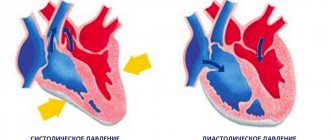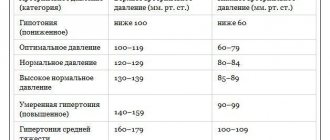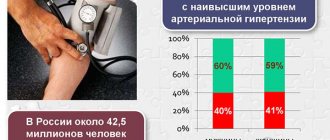When blood pressure (BP) readings deviate from normal by 10–15 units, most doctors do not see any danger in this. Each organism is unique, which means that completely different indicators can be considered normal. And small deviations can be caused by emotional experiences or increased physical activity.
However, there are maximum permissible deviations, beyond which there are pathological conditions.
So, a pressure of 90 over 60 and below indicates hypotension, and 140 over 90 mmHg. Art. - about hypertension. This means that all other indicators that are within the specified values can be considered optimal. And when the pressure is 120 over 90, what does this condition mean? Can it be considered normal or is it evidence of some kind of pathology? Let's try to figure it out based on the concepts of norms.
Normal or pathological 120/90
Optimal blood pressure is generally recognized as 120/80, which is the norm for 75% of the world's population. A deviation of the diastolic or systolic marker by 10-15 units in any direction is not critical.
Most often, this is a sign of physical or emotional stress. Doctors say that blood pressure 120/90 without deterioration in general well-being and the absence of negative symptoms is quite acceptable.
But as soon as such numbers are accompanied by unpleasant symptoms and cause discomfort in a person, we are talking about a pathological deviation from the normal level. At the same time, no one has canceled individual physiological characteristics.
A pressure of 120 over 90 may be the only symptom of an emerging pathology in the following categories of patients:
- teenage children without gender differences, especially with a pulse of 80-90 beats/minute;
- hypotension: such indicators are a sign of isolated diastolic hypertension;
- hypertensive patients with the development of tachycardia.
Possible fluctuations in blood pressure are presented in a table.
| Blood pressure indicators | What does it mean |
| 120/80 | Impeccable |
| 120/80-129/89 | Normal |
| 140/90 | High |
| 140/90-159/99 | Slightly elevated |
| 160/100-179/109 | Average degree of headache |
| 180/90 | Very high |
| 90/60 | Decreased |
There is a tendency for blood pressure to increase, corresponding to the formation of pathology. But it should be taken into account that any fluctuations are correlated with age and gender.
Blood pressure 120/90 with altered pulse
Blood pressure level and heart rate are two interrelated parameters. Thus, when blood pressure fluctuates, the frequency and rhythm of the pulse changes. A pulse of 100 beats/min at normal pressure indicates the development of an attack of tachycardia.
A rapid heartbeat at values of 120/90 may be a physiological phenomenon due to stress, physical exertion, mental stress, or drug overdose. This disorder is temporary, since after the provoking factor is eliminated, the pulse independently returns to normal parameters.
Pathological causes causing tachycardia:
- dysfunction of the thyroid gland;
- heart and vascular diseases;
- infectious diseases;
- pathologies of the pulmonary system.
If palpitations are accompanied by pain in the heart area and are persistent, the patient should consult a cardiologist to determine the cause of the disorder.
No ads 3
What is its danger, including for pregnant women?
A blood pressure of 120/90 is considered normal in the absence of negative symptoms; this also applies with absolute certainty to pregnancy. Habitual hypotension in pregnant women is almost the same physiological condition. This is the range of the golden mean when changing hormonal levels, taking into account the age of the expectant mother, the presence of concomitant pathologies, and the timing of pregnancy.
| Trimester, weeks | Characteristic |
| First trimester | Hypotension, below 120/80 |
| 17-18 week | 120/90 is considered as the norm with optimal blood pressure values before conception (in expectant mothers over 35 years of age, blood pressure before pregnancy is initially slightly elevated - 140/90) |
| 25-26 week | Blood pressure is above 120/90, but in the absence of negative symptoms and deterioration of health, this is the norm; the addition of any symptom of malaise requires consultation with a doctor |
The indicators indicated in the table do not pose a danger to either the mother or the unborn child.
Reasons for rising DBP
In a healthy person, DBP equal to 90 units does not require clarification of the reason for its increase, since this is the norm. In hypotensive patients, such figures indicate a pathology associated with an unbearable load on the myocardium. This happens if:
- alcohol intoxication occurs;
- drinking caffeinated drinks excessively;
- certain medications are used;
- the condition of weather-dependent people worsens;
- a person catches a cold;
- there is a dysfunction of the kidneys and adrenal glands;
- hormonal levels change:
- a tumor of the pituitary gland is formed;
- diabetes mellitus, cardiovascular pathologies, and VSD start.
In hypertensive patients, pressure 120/90 is considered low, since age-related changes are organic and irreversible, vascular tone is impaired.
Reasons for increased diastolic value
Why does diastolic blood pressure increase? When an elevated lower parameter is initially detected, blood pressure levels should be constantly monitored at different times of the day. The reasons for the increase in diastolic indicator can be both physiological and pathological. In most cases, the increase is associated with an increase in vascular tone and a decrease in their elasticity. This condition occurs when the following problems occur:
- Kidney diseases, when there is a decrease in blood circulation to their tissues as a result of the atherosclerotic process.
- Diseases of the thyroid gland, accompanied by excess production of hormones that activate the activity of the autonomic nervous system.
- The development of atherosclerotic processes in the arteries, which leads to vascular spasm.
- The presence of an intervertebral hernia that compresses blood vessels.
An increase in the diastolic parameter with a normal systolic parameter may be a sign of heart defects or neoplasms
Constant factors that provoke an increase in the lower parameter are also:
What does pressure 125 over 70 mean?
- Smoking causes prolonged vasospasm.
- Alcohol depletes the compensatory mechanisms, due to constant periods of spasm and relaxation of the arteries.
- Stress activates excess production of adrenaline, which causes constriction of the arteries.
- Excessive salt consumption contributes to fluid retention in the circulatory system.
- Physical inactivity and excess body weight lead to edema.
Increasing blood pressure parameters to 120 by 95 mm. rt. Art. serves as a reason to undergo a full diagnosis, which includes a number of instrumental studies, as well as a comprehensive blood and urine test.
An increased lower value with a normal upper value means the beginning of the development of isolated diastolic hypertension. This ratio serves as a sign of pathological processes in the body.
No ads 2
Symptoms
Usually a blood pressure of 120 over 90 does not give any negative symptoms. But in hypotensive patients, such numbers can cause:
- migraine;
- tachycardia;
- stimulation of the nervous system.
In hypertensive patients, this is the result of an overdose of antihypertensive drugs, which causes drowsiness, apathy, lethargy, and chronic fatigue, which is corrected by stopping the usual medications.
Weather-dependent people react to unusual pressure of 120/90 by changing their heart rhythm. Tachycardia makes them irritable and aggressive; if such pressure is demonstrated by a hypotensive patient, migraines appear, ringing in the ears, spots flashing before the eyes; in hypertensive patients, ataxia occurs, a condition reminiscent of fainting.
If the pulse slows down, then hypotensive patients have paler skin, the remaining strength disappears, the pressure can drop sharply and further, accompanied by coma and cardiac arrest. Hypertensive patients react to bradycardia by developing neurological symptoms similar to VSD.
Is adjustment needed?
In the absence of complaints or deterioration of health, no correction is required. If negative manifestations occur, then correction is necessary.
At home
First aid at home can be done as follows:
- lie down, relax, breathe deeply, evenly, limit any movements to prevent a further rise in pressure;
- open the window;
- loosen tight clothing;
- drink a glass of rosehip decoction, pomegranate juice - vitamin C will strengthen the wall of blood vessels;
- take sedative drops such as Corvalol, and regularly perform tonometry.
The lack of results after half an hour is a reason to call an ambulance.
Medicines
Doctors consider an increase in DBP with normal SBP to be isolated and suggest:
- to refuse from bad habits;
- adjust the diet, limit salt;
- add dosed sports activities to your daily routine;
- from medications - take diuretics such as Spironolactone, adrenergic blockers (Betaloc), ACE inhibitors (Captopril), calcium antagonists (Norvasc).
All manipulations are controlled by a doctor.
Traditional methods
Among the folk remedies it is recommended:
- cranberry juice with honey in equal parts: a teaspoon, three times a day, for 14 days;
- honey with onion concentrate in equal parts, taken according to the same scheme;
- rosemary decoction;
- baked garlic (10 minutes in the oven) with bread;
- infusion of hawthorn, motherwort, valerian.
If DBP is consistently high at 90 units, the kidneys should be examined.
What is blood pressure and what does it depend on?
Blood pressure refers to the force of blood pressure on the walls of blood vessels, measured in millimeters of mercury. There are venous, intracardiac, capillary and arterial pressure (BP).
It is blood pressure measurement that has the greatest practical value. The indicator includes two numbers:
- Upper pressure is the effect of blood on the walls of blood vessels during the greatest contraction of the heart, at the moment of blood ejection. The number is fixed when the pressure in the vessels reaches its maximum value.
- The lower pressure, which is recorded at the moment of greatest relaxation of the heart.
The difference between the upper and lower values is called pulse pressure, its norm is 35-50 mmHg. Art.
The value of blood pressure is influenced by:
- Floor. As a rule, women have 10-20 units lower than men.
- Body mass.
- Age. With age, blood pressure increases.
- The presence of bad habits.
- Psycho-emotional state.
- Physiological features, including heart volume.
- Taking certain medications.
- Presence of chronic diseases.
- Diet.
Most doctors are skeptical about averaging blood pressure standards depending on the gender or age of patients, preferring an individual approach in each situation.
When do you need a doctor?
They resort to the help of a doctor in a situation of consistently high DBP (at the initial level – 80 units and below), which is not corrected either by medications or folk remedies, and causes a deterioration in the general condition. Blood pressure 120/90 is not critical and does not require emergency measures, but a full clinical and laboratory examination in such a situation is recommended and justified.
If the leading symptom is chest pain, seeing a doctor is absolutely necessary so as not to miss the development of fatal complications from the heart and blood vessels.
Complications
Complications with high lower blood pressure, 125 over 95 may be just the beginning, can be very serious. If the diastolic arterial value is high for a significant time, the process of sclerotic changes may begin:
- connective tissue grows;
- replaces organ cells;
- the functioning of the organ is impaired.
Such a process in the heart can lead to myocardiosclerosis. As the disease progresses, stagnation of blood circulation occurs, which leads to cardiovascular failure.
Problems of blood stagnation in the systemic circulation lead to:
- swelling;
- ascites.
Cardiovascular insufficiency in the small circle can cause:
- shortness of breath;
- pulmonary edema.
Complications can affect the brain:
- problems with intelligence;
- memory impairment.
A high lower value may contribute to the development of diseases. Problems with kidney function can develop into kidney failure.
Forecast
If you follow your doctor's recommendations:
- quitting smoking, alcohol, drugs, energy drinks, caffeine-containing drinks;
- balancing the diet with limited salt, a predominance of fresh fruits and vegetables;
- increased physical activity;
- dosed physical activity;
- prevention of stressful situations;
- good dream;
- clinical examination – the prognosis is favorable.
Blood pressure 120/90 is not a condition that requires any special, emergency measures if a person’s optimal blood pressure corresponds to the age norm and does not go beyond fluctuations of 10-15 units in both directions.











